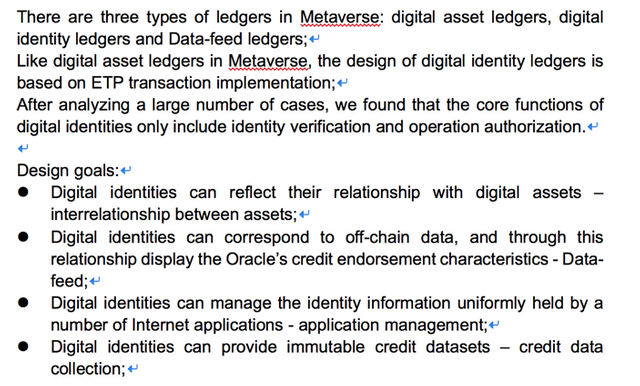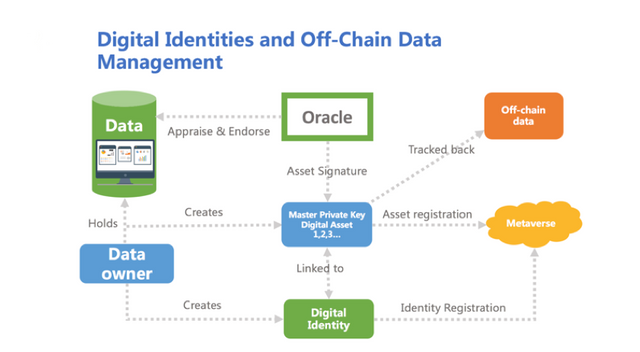Metaverse CTO Chen Hao talks about digital identity via a Live-streaming Show [part2]
What kind of digital identity can be built with blockchain technology? I’ve just posted a picture (generally referring to public blockchain products). What can we achieve through adopting public blockchain technology? Our team has explored several areas. We can see from the picture that off-chain data can be imported into digital identities. This is the association of off-chain data with the blockchain, and we call it Data-feed. There is another area called application management, that is, using your digital identity to manage other applications. Additionally, credit data may be collected and used to provide credit authorization for some applications.
Firstly, what is off-chain data management? In fact, we can see from our analysis that blockchain is a relatively exclusive system. How can this exclusive system be connected with existing internet applications and data? The original data must be exported to the chain. As a general rule, we cannot simply upload data onto the chain because not all data is trustworthy. When collecting online data, there will be some unreliable information, a problem which cannot be solved by coding. Thus, we introduced a concept called Oracle. This Oracle does not refer to the company Oracle’s database, but a value intermediary. Oracles will be responsible for endorsing and signing all off-chain data. Endorsement is a financial concept, while the signature is a technical concept; together they allow off-chain data to be imported. A data import generally requires four steps. 1) Users with data establish a digital identity on the blockchain and provide a way to input their data, 2) pack and encrypt the data, 3) directly broadcast it to the entire blockchain; then 4) Oracles (value intermediaries) qualified to carry out data validation will be asked to endorse and sign the data to signal agreement. It can be any kind of data, including ID cards and education certificates. Other users may view the details of this data after they have been authorized by the data owner.

As we can see from the diagram above, data and data owners are pictured on the left. The owner imports off-chain data to Metaverse (the public blockchain) with his digital identity; the Oracle then appraises and endorses the data.
The second area we have explored is application management, referring to the use of encrypted blockchain technology to manage internet identities, achieve autonomous identities as well as to protect your personal information. We plan to use digital identity to authorize access to information from other applications, allowing users to personally manage their digital identities. But how can we achieve this? We put forward a concept called BaaS (Blockchain as a Service), an extension of cloud computing that outlines how public blockchain technology can be adopted to build BaaS services. As a result, users may build such a platform using the tools provided by a public blockchain such as validation, licensing, asset and financial tools as well as options contracts. You can use these tools to link identity and assets and build your own financial applications. In the meantime, you may also develop your application into an open platform. There is no difference between this platform and traditional internet applications; the only difference is that your platform uses public blockchain infrastructure, which is publicly available. For example, after executing an asset-backed transaction, you can easily prove that the transaction has taken place by showing its corresponding record.
As the blockchain is immutable, open and transparent, these deals are trustworthy. As long as you use the tools on the public blockchain, you may use your digital identity to prove your identity.
The third area we have explored is credit data collection.We initially planned to design it as an evaluation system, using the nature of a public blockchain as a self-contained accounting system. Because of its openness and anonymity, if we add identity information into the system, we can link a set of data to identities. After collecting all the data, users may freely choose whom their information is revealed to. In an institution, for instance, the data linked to me would include my asset information, the amount of assets I currently hold, the transfers I have made, transfer amounts and the number of people authorized to operate the account. This digital identity data can be retrieved with an algorithm and selectively released to a community through a non-public interface. This allows others to view my digital identity’s credit data, creating a seamless data linking and verification process: I import my assets from off-chain to on-chain, then prove to others that my assets are valid and credible.